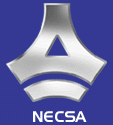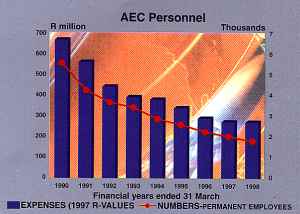Index | Search |






PO Box 582 Pretoria 0001 Tel: +27 12 305-4911

 In response to a request in 1944 for accurate forecasts on the uranium potential of South Africa, the Uranium Committee first met in 1945 under the chairmanship of Dr Basil Schonland. In 1948 the South African Atomic Energy Board (AEB) was established by an Act of Parliament to exercise control over the production of, and trade in, uranium. This Act was amended in 1959 to make provision for research, development and utilisation of nuclear technology. In 1970, the Uranium Enrichment Corporation (UCOR) was established, and a large program of uranium conversion, enrichment and fuel fabrication was initiated in the 1970s. In 1985, together with the Nuclear Development Corporation (NUCOR), UCOR was incorporated into the Atomic Energy Corporation (the AEC, formerly the AEB). The primary mandate of the AEC (and its former subsidiary companies) in the 1970s and 1980s was to develop an indigenous nuclear fuel cycle for powering nuclear power plants and for providing material for nuclear weapons.
In response to a request in 1944 for accurate forecasts on the uranium potential of South Africa, the Uranium Committee first met in 1945 under the chairmanship of Dr Basil Schonland. In 1948 the South African Atomic Energy Board (AEB) was established by an Act of Parliament to exercise control over the production of, and trade in, uranium. This Act was amended in 1959 to make provision for research, development and utilisation of nuclear technology. In 1970, the Uranium Enrichment Corporation (UCOR) was established, and a large program of uranium conversion, enrichment and fuel fabrication was initiated in the 1970s. In 1985, together with the Nuclear Development Corporation (NUCOR), UCOR was incorporated into the Atomic Energy Corporation (the AEC, formerly the AEB). The primary mandate of the AEC (and its former subsidiary companies) in the 1970s and 1980s was to develop an indigenous nuclear fuel cycle for powering nuclear power plants and for providing material for nuclear weapons.
The principal roles of the Atomic Energy Corporation [AEC] have been to manufacture nuclear fuel for the reactor at Koeberg power station, to participate in the discontinued nuclear weapons program and to perform research which supported these functions. Situated at Pelindaba, 30 km west of Pretoria, the Atomic Energy Corporation manufactures, markets and supplies a range of hi-technology products and services to most South African market sectors and various foreign market sectors. The Atomic Energy Corporation was established in Pretoria in 1948 to assess the uranium reserves in Southern Africa. When it was decided that nuclear research and development should be undertaken, the AEC moved to Pelindaba. The SAFARI-1 nuclear research reactor, was acquired from the United States as part of the Atoms for Peace program in 1965. Over the next 20 years two uranium enrichment plants were built. The first plant provided weapons grade material while the second produced low-enriched uranium for the manufacturing of fuel for nuclear power stations.
With political changes in South Africa and economic developments in the world, the AEC entered a new phase in 1990. Since 1990, following its new 2000 Plus Plan, the AEC has re-directed its role from a largely strategic to a largely commercial one. This process resulted in large scale rationalisation (notably the closing down of the enrichment program in 1995) and in a re-focussing of its core competency areas, which now include irradiation processes, fluorine based chemicals and applications and laser-based isotope separation technology. Fundamental research still takes place at the AEC using the SAFARI research reactor. The use of SAFARI as a National facility promotes its optimum use by university researchers and enables vocational training. The AEC receives government funding for technology development and industrialisation activities. Recently the AEC changed its name to NECSA - the South African Nuclear Energy Corporation.
